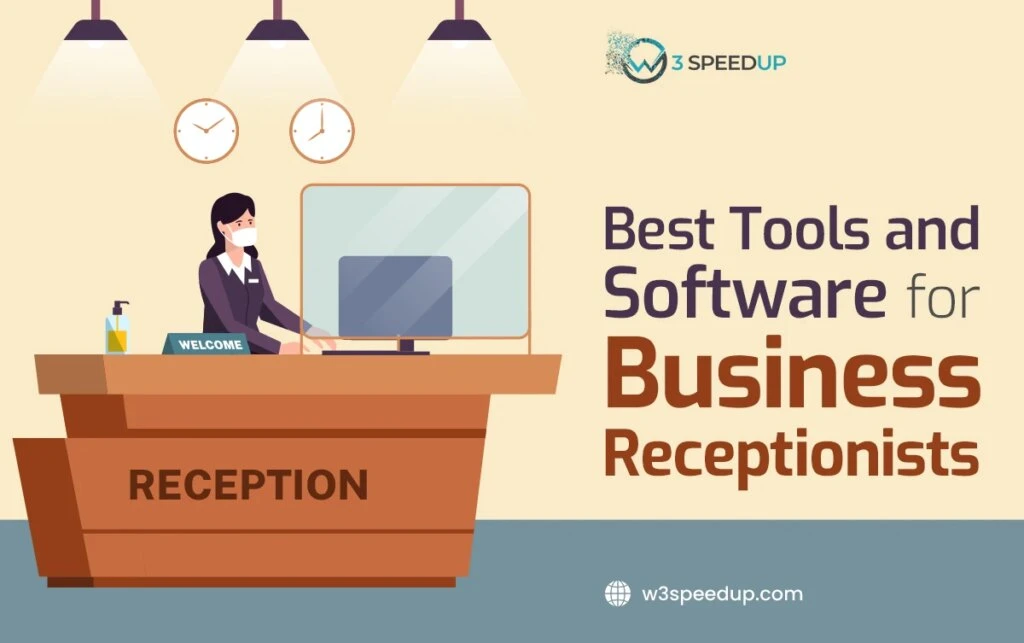In the fast-paced world of business, receptionists play a crucial role in managing first impressions and ensuring smooth operations. Yet, their task list can be overwhelming without the right tools and software. If you’re a business receptionist or managing one, understanding which tools can enhance efficiency and productivity is key. This blog post dives into the top 7 tools and software every business receptionist should consider incorporating into their daily routine. From managing appointments to streamlining communications, these tools are designed to make the life of a receptionist easier and more organized.
Importance of Efficient Tools for Receptionists
Being a receptionist is more than just answering calls and greeting visitors. It involves managing schedules, handling various administrative tasks, and ensuring the front office runs smoothly. Having the right tools can make a significant difference in how effectively these duties are performed. Efficient tools reduce the margin for error and free up time for more critical tasks. They also enhance the overall experience for both employees and visitors, making the office environment more professional and welcoming.
 01. Scheduling Software
01. Scheduling Software
One of the biggest challenges for receptionists is managing appointments and meetings. Scheduling software like Calendly or Doodle can automate this process, allowing receptionists to schedule, reschedule, and cancel appointments with ease. These tools integrate seamlessly with calendars, sending automatic reminders and updates to all parties involved. This not only saves time but also minimizes the risk of double bookings and missed appointments. With features like time zone detection and buffer times between meetings, scheduling software ensures that every appointment is well-organized and timely.
 02. Visitor Management Systems
02. Visitor Management Systems
A visitor management system (VMS) is essential for maintaining security and organization in the workplace. Tools like Envoy or iLobby streamline the process of checking in visitors, ensuring that every guest is accounted for and has the necessary permissions to enter the building. These systems can print visitor badges, notify hosts of arrivals, and even provide evacuation lists in case of an emergency. By digitizing the check-in process, VMS tools not only enhance security but also create a more professional and efficient front desk experience.
 03. Communication Platforms
03. Communication Platforms
Effective communication is vital for any receptionist. Platforms like Slack or Microsoft Teams offer centralized communication channels, making it easy to stay connected with colleagues and management. These tools support instant messaging, voice and video calls, and file sharing, ensuring that receptionists can quickly relay information and receive instructions. With features like customizable notifications and searchable message history, communication platforms keep everyone in the loop and foster a collaborative work environment.
 04. Task Management Tools
04. Task Management Tools
Receptionists often juggle multiple tasks simultaneously, from answering calls to handling mail. Task management tools like Trello or Asana help receptionists organize their workload and prioritize tasks. These tools allow users to create task lists, set deadlines, and track progress. By visualizing tasks on boards or lists, receptionists can easily see what needs to be done and stay on top of their responsibilities. Task management tools also facilitate collaboration, allowing team members to assign tasks and provide updates in real time.
 05. CRM Software
05. CRM Software
Customer Relationship Management (CRM) software is invaluable for receptionists who interact with clients and customers regularly. Tools like Salesforce or HubSpot centralize customer information, making it easy to access contact details, previous interactions, and service history. This allows receptionists to provide personalized service and build stronger relationships with clients. CRM software also offers features like lead tracking and reporting, helping receptionists support sales and marketing efforts. By having all customer information in one place, CRM tools enhance efficiency and improve customer satisfaction.
 06. Automated Call Handling
06. Automated Call Handling
Handling calls efficiently is a core responsibility of any receptionist. Automated call handling systems can manage incoming calls, route them to the appropriate department, and provide automated responses for common inquiries. These systems reduce the workload on receptionists, allowing them to focus on more complex tasks. Features like voicemail transcription, call recording, and analytics provide valuable insights and ensure no important calls are missed. Moreover, as folks from Always Answer explain, live call-answering service can also be a great complement to an automated system, providing personalized and professional responses to callers. It’s a cost-effective solution for businesses to provide 24/7 support while freeing up receptionists’ time.
 07. Document Management Systems
07. Document Management Systems
Receptionists often deal with a plethora of documents, from invoices to visitor forms. Document management systems (DMS) like DocuSign or Dropbox Business streamline the process of storing, organizing, and sharing documents. These tools offer secure, cloud-based storage, ensuring that important files are easily accessible and protected. With features like electronic signatures and version control, DMS tools simplify document workflows and reduce the risk of errors. By digitizing document management, receptionists can save time and focus on more strategic tasks.
In the modern business environment, receptionists need more than just a friendly demeanor to excel; they require efficient tools and software to manage their diverse responsibilities. From scheduling appointments to handling communications, the right tools can make a world of difference. By incorporating scheduling software, visitor management systems, communication platforms, task management tools, CRM software, automated call handling, and document management systems, receptionists can enhance their productivity and contribute to a more organized and professional workplace. If you’re looking to streamline your front-office operations, consider integrating these tools into your workflow. Their impact on efficiency and customer satisfaction is undeniable.
 Christmas Mega Sale – Enjoy Up to 50% OFF on Every Plan!
Christmas Mega Sale – Enjoy Up to 50% OFF on Every Plan! 


